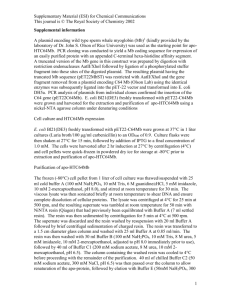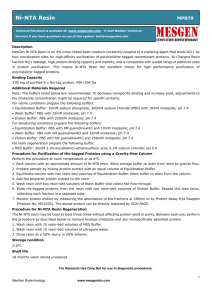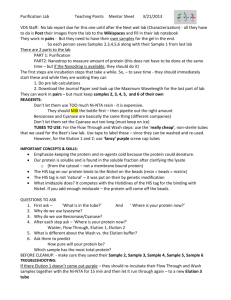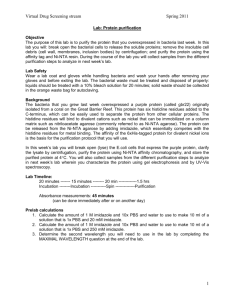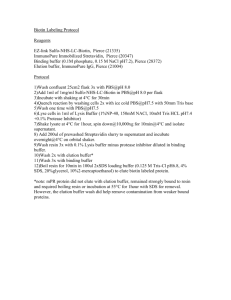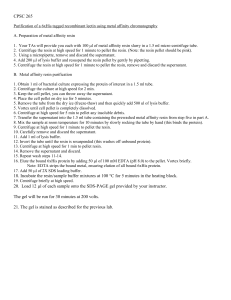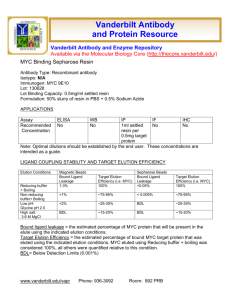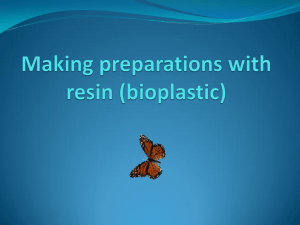5.36 Biochemistry Laboratory MIT OpenCourseWare rms of Use, visit: .
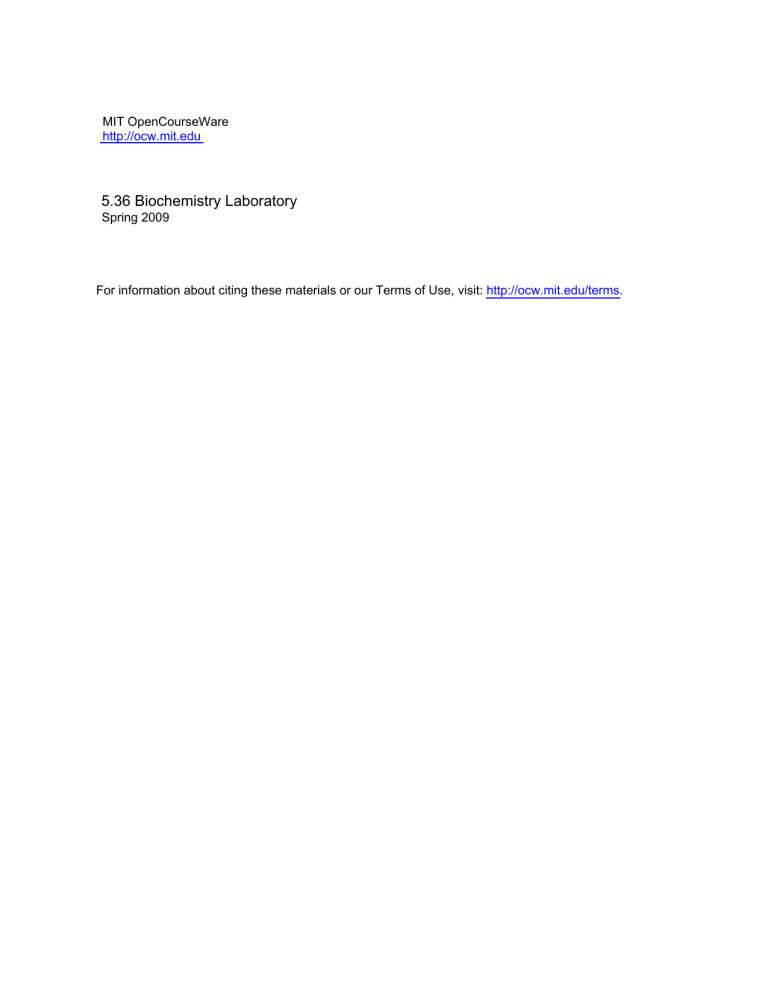
MIT OpenCourseWare http://ocw.mit.edu
5.36 Biochemistry Laboratory
Spring 2009
For information about citing these materials or our Terms of Use, visit: http://ocw.mit.edu/terms .
SESSION 5 (lab open 1-5 pm)
While we wait for the DNA primers to arrive for the mutagenesis, we will focus on purifying the H396P Abl kinase domain. Today you will lyse your H396P Abl(229-511)/
Yop-containing pellet, and isolate the H396P Abl kinase domain via its amino-terminal hexahistidine tag.
Affinity tag purification of recombinant proteins:
A common strategy for isolating a recombinant protein from cell lysate is the use of an affinity tag, which is a small peptide or protein fragment that can reversibly bind to a specifically-functionalized solid support. In affinity-based purification, the protein of interest is expressed with a tag immediately amino-terminal or carboxy-terminal to the protein. After cell lysis, the tagged protein is pulled out of the crude lysate through the binding of the tag to affinity resin. The resin is copiously washed to remove any nonspecific binders, and the protein of interest is then eluted from the column by changing the pH to reduce binding affinity or by introducing a competitive binder. Common affinity tags include the GST tag (a 27-kDa protein that binds glutathione coated beads), the FLAG tag (an 8-residue peptide, DYKDDDDK, that binds a FLAG-antibody functionalized resin), and the hexahistidine tag (HHHHHH, which binds to Ni/NTA functionalized resin). Here we will utilize the hexahistidine tag appended to the aminoterminus of the Abl kinase domain. Since no other proteins in the bacteria have this tag, you should be able to selectively isolate the hexahistidine-tagged H396P Abl(229-511) protein. Elution of the target protein is accomplished by the addition of 100 to 200 mM imidazole, which competes for the Ni binding. The structure of imidazole and histidine are shown in Fig. 2 to demonstrate their identical Ni-coordination sites. In addition to purification applications, affinity tags can also be used for protein visualization on gels.
For example, an anti-hexahistine antibody conjugated with a fluorescent marker can be used to visualize which bands on a gel contain the hexahistidine tag.
Histidine
N
Imidazole
N
N
H
NH
Figure 2 . Structures of histidine and imidazole
Laboratory
1.
) Cell lysis
I.
Thaw the cell pellet on ice or at room temperature.
II.
Add 10 mL of B-PER detergent and 100 µL of a 100X protease inhibitor cocktail solution to the pellet in a 50-mL conical tube. Pipette up and down using a 10-mL pipette until the cell suspension is homogenous. In order to maximize your protein yield, it is essential that the suspension is free of lumps and completely homogenous before moving on to the next step. This may mean pipetting up and down 40 or more times.
21
III.
Add an additional 10 mL of B-PER and 100 µL of 100X protease inhibitor cocktail and pipette up and down 10 to 15 times to achieve a homogenous suspension.
IV.
Gently agitate (by shaking or rocking) the suspension for 10 min at 4 ºC.
V.
Centrifuge the tube at 10,000 rpm for 15 min at 4 °C. Remember to balance the centrifuge with a tube of equal mass, such as another group’s cell lysis mixture.
VI.
Decant the solution (containing your soluble protein) into a fresh 50-mL conical tube. Add Ni-NTA binding buffer to a final volume of approximately 46 mL and immediately continue on to the Ni-NTA purification. If necessary, you can store the lysate on ice if you are waiting for Ni-NTA resin.
VII.
To discard of the cell pellet, add 30% bleach to the pellet in the conical tube. Let the pellet sit in the bleach solution for at least 30 min, then dispose of the pellet and solution down the drain using plenty of water.
2.
) Purification of the H396P Abl kinase domain by Ni-NTA affinity chromatography
While the purification will be carried out at room temperature on the benchtop, all buffers should be stored at 4 ºC and all elutions should be stored in an ice bucket.
I.
To your solution of crude peptide in binding buffer, add a total of 1 mL Ni-NTA pre-activated resin. Note: 1 mL of resin is equivalent to 2 mL of a 50% resin slurry. The slurry can be transferred directly from the resin bottle to your 50-mL conical tube using a pipette.
II.
Gently agitate the resin with your protein solution for 20 min at 4
°
C.
III.
Carefully add the cell lysate/resin mixture to a 20-mL plastic column, and collect the flow through in a 50-mL conical tube. It is very important that you never allow the resin to go dry!
Make sure that there is always at least a small amount of buffer above the resin bed.
IV.
Once the cell lysate reaches the level of the filled resin, wash the resin with 10 mL of binding buffer and then with 30 mL of washing buffer. Collect the flow through in a 50 mL conical tube.
V.
Elute the hexahistidine-tagged Abl protein from the column by adding 1.2-mL aliquots of elution buffer. Collect each 1.2-mL aliquot in a separate, labeled 1.5mL eppendorf tube. Collect 7 elution fractions in total. Fractions containing your protein may be light blue from Ni that has eluted with the protein.
VI.
For subsequent gel analysis (in session 7) remove a 40-uL aliquot from each elution fraction. Carefully label these and store at 4 ºC .
VII.
Combine your elution fractions and dialyze the protein into TBS as described (in section 4.)) below.
VIII.
Wash the column with 10 mL of washing buffer, and deposit your used resin in the designated container for regeneration.
3.) Optional : Absorption measurements of Ni/NTA elution fractions
Measure the A 280 of all fractions. See Appendix A2 for spectrophotometer instructions. Absorption at 280 is a less sensitive detection method than visualization on an SDS-PAGE gel, so you may find that fractions with no detectible protein by UV/Vis
22
have protein present on a gel. In your lab report, you should compare the results for detection by absorption at 280 nm with those for SDS-PAGE gel analysis.
4.
) Dialysis of the purified H396P Abl(229-511) protein
Since the activity of some proteins can be damaged by prolonged storage in buffers with high concentration of imidazole, you will dialyze your eluted H396P Abl(229-511) fractions into TBS buffer. Consider the sizes (molecular weights) of the components in you elutions: the hexahistidine tagged Abl kinase domain is approximately 32 kDa , and the imidazole is 68 Da (0.068 kDa). Therefore using a 10 kDa MWCO (molecular weight cut off) dialysis device should easily enable removal of imidazole from the protein solution.
Based on the Ni-NTA elutions that contain detectable protein by absorption at 280 nm, combine all elutions with a significant concentration of the Abl domain. (Alternatively, you can combine all 7 elution fractions if you did not measure the A 280 values.) Soak a
10-kDa MWCO dialysis cassette in 1X TBS or water for at least ten minutes. Using a syringe, carefully load the protein solution into the dialysis cassette. Be careful not to pierce through the side of the cassette. Please have your TA observe you during this step to ensure the correct protocol is being followed and that no protein is lost.
Using the Styrofoam floatation clips, float the cassette in 2 L of cold TBS. Dialyze your protein at 4
°
C overnight. In preparation for buffer exchange, chill another 2 L of TBS at
4
°
C overnight. Tomorrow you will exchange the dialysis buffer with the fresh prechilled TBS.
SESSION 5B (lab open 1-2 pm)
Exchange the dialysis buffer with fresh pre-chilled TBS, and continue dialysis at 4
°
C.
The used TBS can be poured down the drain to dispose.
23
